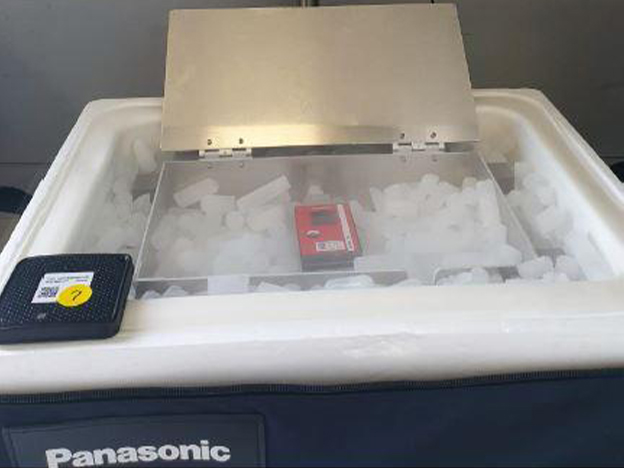Example of the use of VIXELL in international transportation
Case 2. International transportation from Europe to Japan (temp. range : -60℃ or less)
・Purpose: Actual transportation test assuming the import of investigational products from Switzerland to Japan
・Period:
International transportation : From 14th September,2021 to 22nd September,2021
Storage in Japan: From 23rd September,2021 to 4th October, 2021
・Transportation route:
Switzerland (Basel) → Belgium (Brussels Airport) → Germany (Frankfurt Airport)
→ Japan (Kansai International Airport) → Kobe (SUZUKEN Co., LTD. Hanshin Distribution Center)
→ Kyoto (NISSIN CORPORATION Kyoto Sales Office)
・Transportation temperature range : -60 ℃ or less (dry ice temperature range)
・Equipment used
1 VIXELL Type-L (AE-V12UXR) + thermal storage unit for dry ice temperature range(AE-V12DXR)
2 VIXELL Type-S (AE-V06GXR) + thermal storage unit for dry ice temperature range(AE-V06DXR)
・Measurement recorder
Inside of VIXELL: ELPRO-BUCHS AG temperature data logger LIBERO CD (temperature only)
Outside of VIXELL: IoT device sensor tag (temperature, humidity, illuminance, tilt, impact, etc.)
* This transportation experiment was a joint transportation experiment with NISSIN CORPORATION and SUZUKEN Co., Ltd.
In the recent transportation of pharmaceutical products, the introduction of GDP (Good Distribution Practice) is progressing, and strict temperature control is required. There is also an increasing need for high-quality ultra-low temperature transportation, as represented by the transportation of COVID-19 vaccines.
In the conventional constant temperature transportation of pharmaceutical and investigational products in dry ice range, the thermal insulation performance of the cold insulator box is poor and the temperature holding time is short. Therefore, the problem was that the airport in the country of departure had to compensate for the dry ice consumed in the transportation before export, and in some cases, the airport in Japan in the country of arrival had to perform additional filling of dry ice in accordance with the domestic transportation time to the final destination.
This time, in order to verify the cooling performance of VIXELL, we carried out a transportation test under minus 60 ° C using the same air route as the actual transportation of pharmaceutical products from Europe to Japan. We prepared two types of VIXELL, Type-L and Type-S, filled the inside of VIXELL with pellet-type dry ice at the warehouse of a partner company in Switzerland, the country of departure. We installed mock pharmaceutical products and loggers with various sensors, and measured sensor information such as temperature inside the VIXELL. In actual international transportation, the temperature maintenance performance is often required to be about 5 to 7 days. However, there are cases where problems beyond the expected number of days occur, such as transshipment at the transit point or customs clearance at the destination airport. Therefore, we believe that the temperature maintenance time is originally required to be more than 7 days.
Therefore, in this experiment, we also confirmed how many days the temperature could be maintained only with the first filled dry ice without replenishing the dry ice after opening the package once upon arrival at the destination (Kobe) for checking the remaining amount of dry ice
In this transportation experiment, we also confirmed that the sensor information (Temperature, humidity, illuminance, inclination, impact and remaining charge) measured by the sensor tag was stored in the cloud from each point in Switzerland, Belgium, and Japan via the communication network, and that it could be confirmed on the Internet management screen before arriving at the final destination (Kyoto).

Step1:Filling of dry ice

14th September
The Swiss partner company filled the inside of VIXELL with dry ice pellets (diameter 16 mm). Type-L was filled with 32 kg and Type-S was filled with 13 kg of dry ice to prepare for transportation.
* The storage volume of goods is 2ℓ for Type-L and 1ℓ for Type-S.
Step2:Transportation within Europe

15th September
VIXELLs were transported by land from Basel,(Switzerland) to Brussels(Belgium) by a constant temperature truck.
Step3:Customs procedures


16th September
After completing the export procedures at Brussels Airport in Belgium, necessary labels are attached for export and departed.
Step4:International transportation

18th September
VIXELLs arrived at Kansai International Airport via Frankfurt Airport in Germany. The flight time was about 10 hours and 30 minutes. In addition, until 22nd September after arrival, VIXELLs were stored in the refrigerated warehouse of the import / export warehouse in the bonded area.
Step5:Check the remaining amount of dry ice


22nd September
VIXELLs were transported from Kansai International Airport to the Hanshin Distribution Center of SUZUKEN Co., LTD. (Kita-ku, Kobe City), and at this point, VIXELL was opened for the first time after the departure in Switzerland.
It was confirmed that the remaining amount of dry ice was sufficient even though it had been more than a week since the departure.
Step6:Measurement of maximum number of cold storage days

24th September to 4th October
Furthermore, we moved VIXELLs to the Kyoto office of NISSIN CORPORATION and continued the observation. in order to confirm the maximum number of cold storage days.
Finally, the inside temperature of the Type-S was recorded until 24th September, and the inside temperature of the Type-L was recorded until 4th October.
Results of international transportation test

Summary
In the actual transportation test filled with dry ice from the departure country Switzerland to the arrival country Japan, it was confirmed that the temperature inside the VIXELLs could be maintained below -60 ° C for below period.
・Type-L : 19 days + 3 hours
・Type-S : 9 days + 12 hours
At the same time, by using the international roaming SIM and the gateway device, it was confirmed that the sensor information measured by the sensor tag installed in VIXELL could be monitered in the VIXELL Cloud even before arriving at the destination.



